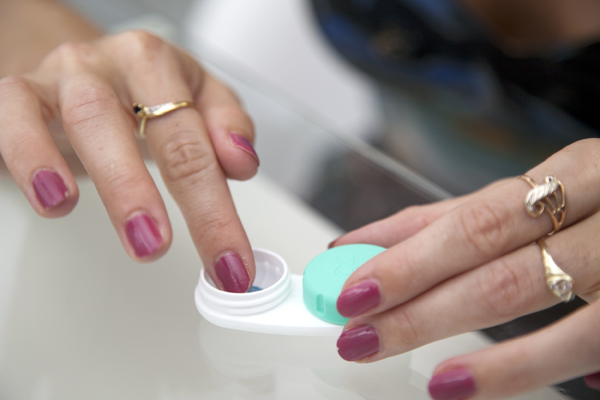Dr. Nishal Govindji-Bhatt, a post-doctoral research fellow at the University of Manchester in the UK, and his colleagues have developed a small bacterial sensing device – a microbiosensor – to allow contact lens wearers to know when to change their lenses. Wearing bacteria-contaminated contact lenses can lead to severe eye infections – an occurrence that could be reduced by using the new device.
According to Govindji-Bhatt, “We have devised a real-time sensing device – embedded within a contact lens case – which is capable of signaling the presence of abnormally high levels of live bacteria. The research was presented at the 55th American Society for Microbiology (ASM) Interscience Conference of Antimicrobial Agents and Chemotherapy (ICAAC/ICC).
The researchers note that in addition to its potential use by consumer contact lens wearers to reduce the incidence of eye infection – and subsequent antibiotic use – the microbiosensor could be used by clinical trial professionals to study the bacterial growth associated with contact lenses.
Govindji-Bhatt said, “The aim of the study was to develop a sensor embedded in the base of a contact lens case that changes color when a high level of bacteria is present.” This simple visual cue would alert the user that the contact lens was not clean enough to be put into the eye.
A tetrazolium dye – also known as MTT – was used to produce a colour change when the bacteria reached one million counts in an 8 hour period. The researchers quantified the bacterial load in 1 mL of solution, and noted that the colour change occurred regardless of the contact lens solution used.
To maintain good eye health, contact lens cases must be kept as clean as the lenses themselves, from bacteria and other irritants. Eye care professionals recommend the use of contact lens solution – which contains disinfectants – to clean lens cases.
“If this cleaning regime is not followed regularly and correctly, contact lenses can become covered in bacteria, and when put into the eye it can cause severe eye infection and in rare cases, a loss of vision,” said Govindji-Bhatt.
In order to optimize performance of the microbiosensor, the researchers tested a number of tetrazolium dyes. Govindji-Bhatt said, “We tested if a color change from yellow to dark blue would take place when harmful levels of bacteria were present, and ensured that the color change could be clearly seen by the user.”
According to the Centers for Disease Control and Prevention, there are more than 30 million contact lens users in the US. In addition, one out of every 500 contact lens wearers will be affected by a serious eye infection associated with contact lens use, every year.
Sources:
- Microbiosensor: a device for monitoring bacterial contamination in contact lens cases –http://www.medicalnewstoday.com/releases/299756.php
- CDC Contact Lens Fast Facts – http://www.cdc.gov/contactlenses/fast-facts.html












Join or login to leave a comment
JOIN LOGIN